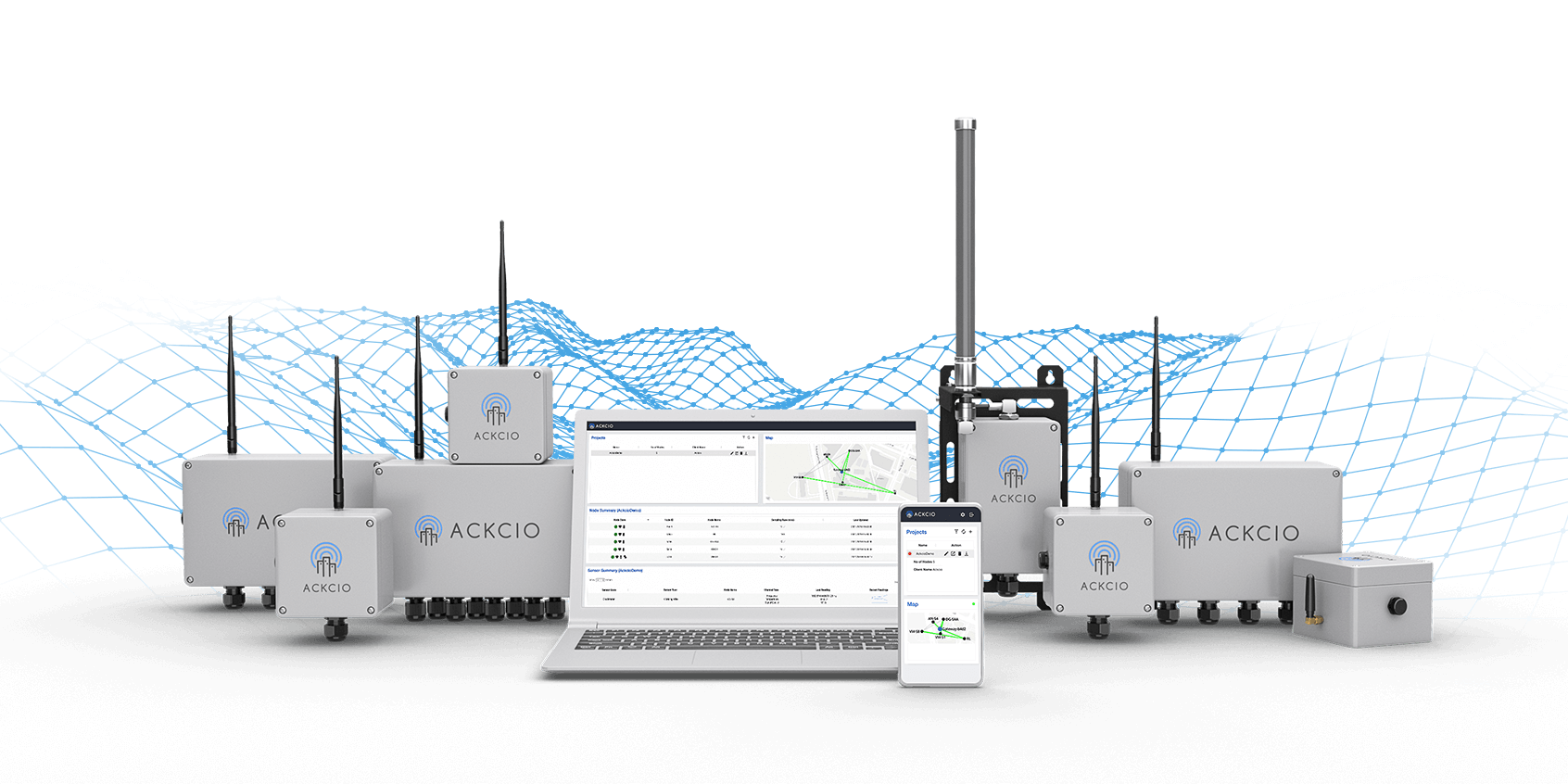Introducing Version 5.X of Ackcio Beam Firmware and Software

The passionate Engineering team at Ackcio has been hard at work at adding a whole collection of novel features to the Ackcio Beam system. These major upgrades address the client and partner feedback we have received in deploying our Ackcio Beam wireless monitoring system in a variety of project settings all over the world.
The upgrades were carried out in:
- Ackcio Mesh – the firmware running on all Ackcio devices
- Snape – the data management software running on Gateways
- Nimbus – the configuration app used on Android smartphones
These upgrades come installed by default in all devices we ship from October 1st, 2020. If you have obtained devices prior to that and would like to upgrade to 5.X, please contact our friendly Customer Success team, and they would be happy to upgrade your devices and also provide a quick training session to guide you through the new features.
Ackcio Mesh Upgrades
The following upgrades are now available in the 5.X firmware running on all Ackcio devices.
Automatic Network Set-up – Self-Forming/Self-Healing
We have implemented a novel set of algorithms to automate the Ackcio Mesh network setup in your project. The Ackcio Beam devices now identify other devices that share the same project and automatically create a network structure that connects all Nodes directly or indirectly to the Gateway. In our earlier releases, this had to be done manually on Nimbus, our smartphone app, by a complicated and manual hop count configuration process, which we have now completely eliminated.
The network set-up process is now fully automatic so you no longer have to manage this process. We have built this feature using the industry-standard RPL algorithm, which is standardized in RFC6550. Once the Ackcio Mesh network is established, then the connectivity is constantly monitored for changes. If a Node disappears or a new Node appears, then the network will change itself automatically to accommodate the change, without any user interactions.
- Long-Range and Scalable Coverage
Ackcio Mesh network is based on the IEEE802.15.4g/e standard, which is a robust long-range network that provides reliable sensor data collection for most industrial applications. The devices can stretch as far as 8 hops, making deployments in challenging environments, especially underground mines and tunnels, plausible.
- Improved Reliability with TSCH – Time Slotted Channel Hopping
We have implemented a TSCH protocol to make the Ackcio Mesh network operate with less packet collision and higher reliability. A TSCH network has proven to have a reliability of up to 99.99%. With TCSH set up for up to 100 channels, all Ackcio devices meet the FCC and CE requirements of frequency hopping.
TSCH also helps the Ackcio Mesh network operate with high reliability in environments where interference from other wireless transmissions is high. A message lost between two devices will be re-sent on a different channel in the next available time slot and thus helps to reduce data loss.
Other Improvements
Enhanced Security – Generate dynamic AES 128 encryption keys to keep your data secure in all your deployments.
Low-Latency Bi-Directional Communication – You can trigger on-demand messages from the Gateway to Nodes. This means actions like sensor sampling frequency updates will be pushed to the Nodes within seconds.
Millisecond-level Time Synchronisation – With the introduction of the TSCH protocol, all Ackcio Beam devices are now time-synchronized to the order of milliseconds. All Nodes in your project will acquire sensor readings simultaneously or very close to the same time.
Enhanced Sensor Support – We have reengineered our wireless protocols to pack more sensor data into a single message. This enables us to support many types of sensors that have a higher number of data channels to transmit. We will be sharing more news about our new sensor integrations in the near future.
Snape Upgrades
Snape, the on-device configuration web software on Ackcio Gateways, is better than ever with the upgrades below.
New and Improved Map Visualisation
The new map on Snape works both when the Gateway is connected to and disconnected from the Internet. It also visualises the link quality, the distance between devices, and the currently used network structure in your projects. If the network topology changes due to obstructions or Nodes being added or removed, the map will automatically show the revised topology as soon as it is formed.
Quick Look at Recent Readings
The new Sensor Summary page shows the 5 most recent readings on a quick chart. This allows for the understanding of the trend of the recent readings for quick decision making.
On-Site Troubleshooting with Diagnostics Reports
The new Gateway Settings page has a Diagnostics section where you can generate a Diagnostics report about the Gateway’s health status. In the event that you experience a problem, this report will flag out errors that would help you to troubleshoot the problem yourself, or provide valuable insights to our Customer Success team to help you resolve the problem quickly.
Other Improvements
Modern and Clean Interface – Interact with the Ackcio Beam system through the modern and clean user interface of Snape. Its responsive design allows you to use it on any browser or device, including smartphones and tablets.
Quick APN Settings – Snape now comes preloaded with APN settings for almost every telco in every country on the planet. This saves you valuable time in setting up Gateway’s cellular modem to work with your telco.
Multi-Upload for Sensor Data – You can now upload data using multiple options (API and FTP) in parallel without having to choose one over the other.
Enhanced Sensor Support – We have reengineered our wireless protocols to pack more sensor data into a single message. We now support many types of sensors that have a higher number of data channels to transmit. We will be sharing more news about our new sensor integrations in the near future.
Remote Connectivity via DDNS – If you are using an Internet connection that provides a public but dynamic IP address to the Gateway, you can access the Gateway via an easy-to-remember URL. You can configure this in the new Gateway Settings page on Snape.
Nimbus Upgrades
The Ackcio Beam Android smartphone configuration app, Nimbus, has gone through multiple upgrades as well.
Interference Scanning
Use the new Noise Test window in our Nimbus application to scan the radio frequency (RF) noise in the spectrum you are planning to use. This information will help you in troubleshooting any range related issues. For example, if you are experiencing a higher level of RF noise, the achievable range might be reduced.
- Quick Setup
Use the new Quick Setup option on our Nimbus app to quickly configure Nodes with a single tap. With this feature, you can completely configure Nodes using our Gateway configuration software, Snape, from the comfort of your office. Those settings can then be transferred to Nodes via Nimbus by just tapping the “Quick Setup” button to configure it with the settings you programmed on Snape.


